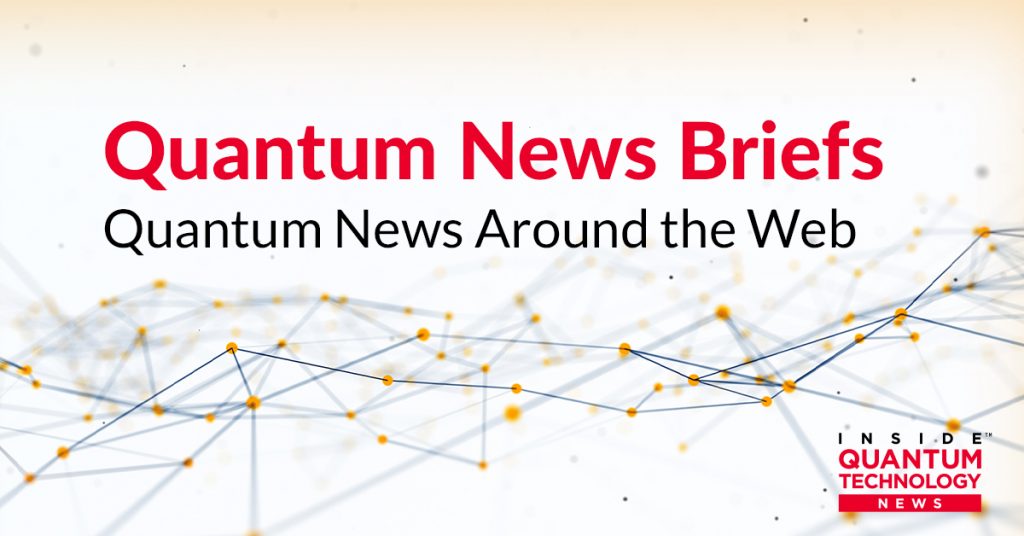Quantum News Briefs September 2 opens with the announcement that Greece is establishing an Institute of Quantum Computing & Quantum Technology followed by AFRL’s experiments with heat flow to manipulate quantum materials. Next is news from WIS@Key about its implementation of post–quantum algorithms in its root of trust services and semiconductors for IoT security and MORE.
*****
Greece to establish Institute of Quantum Computing & Quantum Technology
Christos Dimas the deputy minister for Development and Investments made the announcement this week. Mr Dimas told the Greek parliament that the Institute of Quantum Computing and Quantum Technology would be founded at the National Centre of Scientific Research “Demokritos” in Attica. He also explained that an Institute of of Human Genomics would be founded at Crete’s Foundation for Research and Technology (FORTH).
Mr Dilmas said research findings from the Institute of Quantum Computing and Quantum Technology would have applications across a range of industry sectors. He added that the institute would also establish inter-disciplinary programmes, graduate-school programmes as well as programmes for public administration and business management.
He added that the institute would use European Union research funding in quantum technology which would have a direct benefit on the Greek economy.
AFRL experiments with heat flow to manipulate quantum materials
“The question we’re exploring in our lab is, what are the limits of cryogenic-free phonon engineering for shielding delicate quantum systems from the noisy thermal environment?” said Dr. Chandriker Kavir Dass, AFRL researcher.
Working with the quantum systems in these solid-state platforms is complicated, especially at room temperature.
To remove the influence of the phonons on quantum systems at higher temperatures, AFRL researchers are exploring manipulations of material structure and internal strain to reflect, absorb or “freeze out” the lattice vibrations from disrupting the sensitive quantum systems.
“Much like a sound engineer will acoustically isolate a room to eliminate noise in the recording, or a guitarist will tension a guitar string to select for a particular frequency while freezing out lower frequencies, we are exploring these same ideas in quantum systems,” Kavir said.
At room temperature, the atoms that make up these materials vibrate violently, creating what we know as heat and sound within the material lattice. In the scientific language, these vibrations are known as phonons. Phonons can quickly destroy delicate quantum systems within the host material, so researchers typically cool materials down to very low temperatures in order to avoid these issues.
Maintaining a cold environment requires bulky, power-hungry equipment unsuitable for many potential applications within the Department of the Air Force, or DAF. In response to this problem, AFRL researchers are looking for a solution.
“If we can control and exploit how quantum systems interact with the surrounding environment, we can increase the system’s operating temperature,” said Dr. Robert Bedford, AFRL researcher. “This will strongly impact the suitability of quantum sensing, network and timing in DAF-relevant environments and make large impacts in terrestrial and space applications.”
*****
WISeKey is Implementing Post–Quantum Algorithms in its Root of Trust Services and Semiconductors for IoT Security
WISeKey is developing a new range of Trust Services, that will take advantage of the latest developments in post-quantum encryption (PQE) to be applied in real-world applications of digital signatures and encryption using PKI and digital certificates, such as secure communication channels (TLS), enhanced Key Exchanges and email security (S/MIME). These services are currently based in standards that can be improved to be resilient to quantum attacks and offer backwards compatibility with existing counterparts. WISeKey implementation of PQE is done around the concept of “hybrid signatures” which combine in a single X.509 certificate a conventional signature with a second signature using a PQE algorithm. This approach ensures backwards compatibility and opens a new horizon of cybersecurity services.
WISeKey provided updates on its progress in developing post-quantum resistant algorithms by establishing strategic R&D partnerships with MINES Saint-Etienne Research Institute. WISeKey’s R&D group has been working with several NIST’s candidates for the MS600X Common Criteria products, such as Crystals-Kyber and Crystals-Dilithium, aiming to develop a complete post-quantum cryptography toolbox to be combined with new PKI-related Trust Services delivered by WISeKey.
These post-quantum cryptography initiatives will play a key role in controlling vulnerability and other risks related to quantum computers technologies which when used by hackers can give them the ability to crack cryptography algorithms, corrupt cybersecurity and compromise global economy by undermining the security foundations of the current financial and governmental services. These initiatives have received tremendous support by many government entities around the world through the sponsoring of public/private R&D projects. In particular, WISeKey is active in key initiatives promoted by French Agency for Cybersecurity (ANSSI), and by the National Cybersecurity Center of Excellence of the US NIST.
*****
Penn State materials research model may be bridge to quantum tech
“We establish a new computational model for understanding the dynamics of simultaneous structural and electronic processes in functional and quantum materials, discovering their mesoscale fundamental physics and predicting their functionalities,” said Tiannan Yang, an assistant research professor in the College of Earth and Mineral Sciences at Penn State.
The findings, published in the journal NPJ Computational Materials, represent an advance in the phase-field model — a tool for modeling how the internal structures of materials evolve at the mesoscale, which refers to the size of objects and phenomena occurring between the atomic scale and those observable by the human eye, such as crystal grains, magnetic domains, junctions, and nanoscale materials and devices, the scientists said. Predicting and controlling material behaviors at this spatial scale is critical to translating quantum phenomena into functional devices and systems.
Understanding how the atoms and electrons inside materials will respond to external stimuli like heat, force, electric field or light is essential for predicting the material properties and ultimately harnessing the materials’ functionalities, the scientists said.
*****
Sandra K. Helsel, Ph.D. has been researching and reporting on frontier technologies since 1990. She has her Ph.D. from the University of Arizona.
